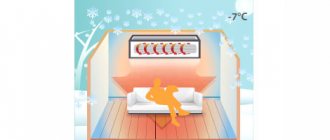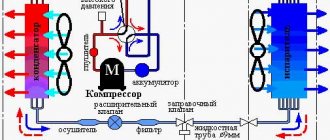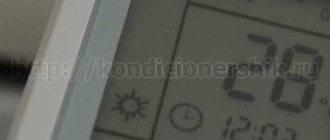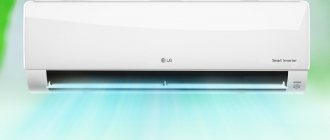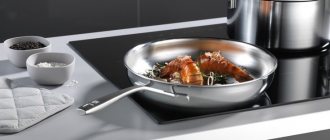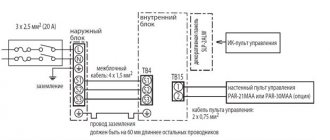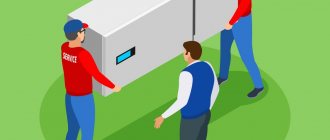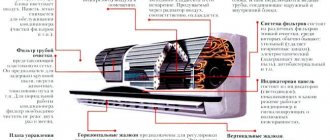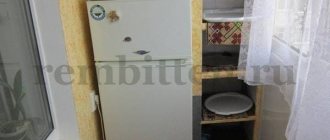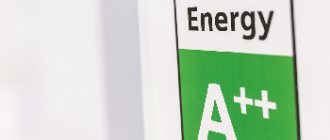Main purpose of the device
The main function of an air conditioner is to cool the room temperature during the hot season, which is why many people go to a hardware store before the start of the summer season. Split systems are equipped with copper cooling pipes that use freon. The indoor module has a heat exchanger through which it evaporates and releases cold air into the room. Near him there is a propeller that drives him back and forth.
Then the heated freon enters the outdoor unit and begins to transform inside it, i.e., it gives off heat and begins to evaporate again and produce cold, which is why almost all split systems have 1 mode - “cooling”.
Operating principle of climate systems
The basic principle of operation of any air conditioning system is based on such properties of liquids as heat absorption during evaporation and its release during condensation . In all air conditioners aimed at cooling, the design is similar with minor changes patented by the brand. The principle of operation of climate control equipment, also intended for heating, is also similar.
For cooling
The operation of air conditioners is based on a closed system in which transformations of a certain refrigerant occur. Thus, the evaporator, condensation unit and compressor are connected by copper pipes, forming a refrigeration circuit within which freon with a small admixture of compressor oil constantly circulates. To cool the system, the following processes occur:
- first, freon in a vapor state is supplied from the evaporator to the compressor, while its temperature is 20 degrees and the pressure is 5 at;
- in the compressor, freon is compressed to 25 at, which causes it to heat up to 90 degrees, and then it is supplied to the condenser;
- freon in a condenser cooled by air masses turns into liquid, releasing heat, since the blowing temperature is below 90 degrees;
- then the warm liquid enters the thermostatic valve - this is a spiral-shaped copper tube, when passing through which the freon finally cools down, its pressure decreases, and part of the substance at the outlet goes into a vapor state;
- then the mixture of gas and liquid phases enters the evaporator - this element is blown with air from the room, so the freon completely turns into steam, in the process taking heat from the air.
Then all the steam is supplied to the compressor inlet, and the cycle begins again. This is how all household air conditioning systems work in the cold.
For heating
The design of air conditioning systems, which also provide heating, consists of similar components, but additionally a four-way valve is installed in it. Thanks to it, the direction of supply and movement of freon is reversed, and the functions of the condenser and evaporator are exchanged.
On a note! To heat the room, the evaporator and condenser perform the same functions as for cooling, but the indoor unit heats the air, and the external unit cools it and releases it into the atmosphere.
Energy efficiency at home
Russian YouTube is full of videos about air-source heat pumps on air conditioners, and for some reason there is a clear tendency everywhere that if someone scolds them, they will definitely miss the advantages of the device and inflate the disadvantages, and vice versa.
This article will touch on both the positive and negative aspects of the issue.
Before you consider heating with air conditioning, check the insulation and energy efficiency of your home.
If it is useless, then no matter how powerful the unit you install, you will not stay warm in winter. And the type of heating has nothing to do with it.
It’s not for nothing that they say that the best heating is insulation! When everything is in order with this, you can start choosing an air conditioner.
Features of winter operation
How many degrees can you turn your air conditioning on in winter? As already mentioned, the minimum operating temperature of a split system is indicated in the instructions for specific equipment:
- most non-inverter split systems are designed to operate down to -5 degrees, some models up to +5;
- most inverter units are designed for operation at -10 - -15 degrees;
- Some heat pump models from leading manufacturers are designed for heating at outside temperatures down to -28 and colder.
The efficiency of a split system is highly dependent on the outside temperature. At temperatures around zero, almost any air conditioner can produce several times more heat than the electricity used.
Is it possible to turn on the air conditioner in winter for cooling or heating?
The answer to this question primarily depends on what type of air conditioner you have.
Some people use mobile devices that look like a candy bar (all in one case) and are located entirely indoors.
Such a device can be safely turned on at any time of the year, since its operation in no way depends on the outside air temperature.
The hot condenser is blown with air taken from the room (like a refrigerator), and when switching to heating mode, the heating element simply turns on. The heat pump turns off and the air conditioner turns into a regular fan heater.
The situation is different with the most popular variety - split systems. Both during cooling and heating, such a device exchanges heat with the external environment, for which part of it - the so-called outdoor unit - is suspended on the street. Of course, in this state of affairs, a lot depends on the outside temperature.
When talking about the operation of an air conditioner in winter conditions, two questions should be considered:
Is this technically possible?
As you know, the most important part of the air conditioner - the compressor - is located in the outdoor unit.
This unit needs lubrication, and it should not be too viscous and not too liquid. This is what depends on the ambient temperature.
If it drops below the minimum allowed by the manufacturer (for most models - (-5) degrees), the oil will thicken and the rubbing parts, practically devoid of lubrication, will quickly wear out and overheat.
How efficiently will the device work?
Let's take a closer look at both modes of operation of the air conditioner:
Cooling
In this mode, the radiator installed in the outdoor unit acts as a capacitor. The refrigerant present here in a compressed state heats up to a high temperature and the colder it is outside, the more efficient the heat exchange will occur. Therefore, from an efficiency point of view, running the air conditioner in cooling mode in winter is quite acceptable.
Air conditioner operation in cold weather
Of course, in a living room there is usually no need for this: in winter, on the contrary, we strive to warm the home, and if it suddenly gets hot, we can open the window for a short time. But in some basement room, completely filled with equipment that generates a large amount of heat, you have to cool the air with an air conditioner even in winter.
Many people today cannot imagine life without air conditioning. But not everyone knows how this device works. If you are interested in how an air conditioner works, read this article.
Is a battery-powered humidifier effective? Read on.
And this topic is all about how to properly organize ventilation in a frame house. Types of systems and installation features.
Heating
Is it possible to turn on the air conditioner for heating in winter and how does the air conditioner work for heating in winter? In heating mode, the external radiator turns into an evaporator. Once here, the refrigerant cools and, in theory, should be heated by the environment. As long as it's not too cold, everything works as it should.
But if the temperature outside drops below the -5 degrees stated by the manufacturer, the refrigerant will have nothing to heat from and the heat performance of the air conditioner will drop sharply, and if it gets colder, it will drop to zero.
Air conditioner operation for heating
How many degrees can the air conditioner be turned on?
Typically, the air conditioner operates in heating mode when the air temperature exceeds -5 degrees. If there are lower temperatures, then the heating system cannot be used due to the process of reducing the power of the system, breakdown of the drainage and the risk of condenser icing and subsequent repair of the inverter.
But some split models are capable of heating air at temperatures of -10 and -15 degrees. At the last mark, inverter-type models can heat the house. They are adjustable, so they are more flexible to temperature changes.
In general, it can be stated that turning on the air conditioner in winter should be done with caution in order to heat up, following the operating instructions. It is better not to use the system if the thermometer shows the critical point declared by the manufacturer.
You may be interested in: Why an air conditioner or split system may not heat
Air conditioning cooling in winter
It may seem strange, but in some rooms it is necessary to remove heat even at low and negative temperatures outside. This applies to rooms containing high-power electrical or heating equipment. For example, server rooms and MRI rooms. But is it possible to turn on the air conditioner in winter for cooling?
Most split systems in the factory configuration are not designed to operate for cooling at low temperatures. Typically, the lower limit is within 5–10 degrees Celsius. For this application, special precision equipment is produced. But its cost is quite high. Can a regular air conditioner be used for these purposes?
Most of the units can be modified so that they cool in winter. This primarily applies to non-inverter units. The main problem with this is that due to the low temperature outside, the freon pressure in the outdoor unit decreases and its condensation becomes more difficult.
To solve this problem, an additional winter kit is installed in the outdoor unit, which regulates the condensation pressure by decreasing and increasing the fan speed. Some manufacturers even officially install winter kits at their dealerships.
Winter set
The winter kit usually includes:
- Drain heater. When working for cooling, moisture condenses in the indoor unit, which can freeze when removed outside.
- Crankcase heater. The compressor crankcase contains oil, which the heater protects from thickening.
- Fan speed controller. It can work either by measuring pressure in the system or by using an air conditioner temperature sensor mounted on the condenser.
We recommend reading: How to clean your home air conditioner yourself
Please note that the winter kit does not help in any way when the air conditioner operates for heating in winter. Of all the above equipment, only the crankcase heater can be used in heating mode. Installation of winter kits is not provided for inverter air conditioners.
Disadvantages and disadvantages of winter heating
Now let's talk about the disadvantages. Don’t think that by choosing a machine with the maximum COP, you will get an ideal heating system that outperforms all others.
A significant drawback of all air conditioners is their noisy operation. There is no escape or relief from the noise.
This is especially annoying in the bedroom. Fortunately, modern inverters have managed to reduce the noise level to 20-30 dB. It's like the rustling of leaves in a slight wind.
In addition to noise, do not forget about the vibration of the external unit. If you have already decided to use air heating in winter, then forget about mounting the external unit on the wall.
Place it only at the bottom on a separate stand with a snow guard.
In summer, when working in the cold, the casing is removed, otherwise the unit will “suffocate.”
Many people place the external unit in the basement of the house. As a result, you get a higher COP, a free refrigerator, and no influence of precipitation. However, the question remains with temperature changes and how they will affect the foundation.
In addition, do not forget about the amount of liquid during defrosting. Over the course of the entire winter season, a small swamp can easily form in your basement.
It is not profitable to use air conditioners for heat in houses with a large area and a large number of rooms isolated from each other. Forget about closed doors with this heating.
To heat two-story cottages, you will most likely need powerful semi-industrial units that cost several thousand dollars. Separate blocks will have to be installed on each floor.
In houses up to 120m2, you can get by with two blocks with a capacity of 9000-12000BTU. In general, with an open plan, count on at least one indoor unit for every 40-50 m2.
At the same time, you still won’t feel the most comfortable heating of the air. Although a thermometer hanging at eye level will show +23C, an unpleasant chill in your legs, especially in distant rooms, will always haunt you.
And for small children this is very critical.
Heated floors are a great improvement over air conditioners in this regard. So, if you have a young family, then most likely you should not switch to heating with air conditioning. If your children are adults or you live alone, then you can safely experiment.
Another disadvantage is that in the absence of a backup heating option, a sudden failure of the external or internal unit will lead to freezing of the entire house.
Of course, you can replace air conditioners with convectors for a while, but what should you do if the electricity is cut off in cold weather?
Buy a powerful generator and switch to a backup source?
But this is again extra costs, unnecessary hassle and a waste of time. Therefore, think through such moments in advance and have at least some temporary alternative.
However, this type of heating is becoming increasingly popular. In general, the main complaints about the unprofitability and unprofitability of heating with air conditioners come from two categories of people:
- who is engaged in the sale, adjustment and installation of traditional heating systems (gas, solid fuel, electric boilers)
- those who bought themselves a cheap Chinese brand
Inexpensive models consume two to three times more than “Japanese” ones with the same thermal power. And they heat normally only when it’s outside down to -5C (the Japanese up to -30C).
Plus they make noise like steam locomotives, and in the end they break down after just a couple of years.
Expensive brands have a MTBF of up to 25 years. Accordingly, the “Japanese” has an average winter COP of 3-4, while the “Chinese” barely reaches 1.5.
To summarize, we can safely say that heating with air conditioning, with a competent approach, has the right to life and can pay for itself in just a few winters.
Even if after this time one of the units fails, replacing it will still be cheaper than connecting, installing, maintaining and operating most traditional heating systems.
What to do with conventional air conditioners in winter
For a simple system, the best solution would be to preserve it for the winter. After turning on the heating, you can prepare the device for wintering. For this:
- Wash the indoor unit filters to remove dirt, then dry and return to their place.
- Turn the air conditioner on fan mode for about an hour to dry it out.
- Disconnect the device from the mains, remove the batteries from the remote control.
If you have a service agreement, specialists will prepare for winter more thoroughly:
- They will pump freon into the street block.
- The system will be completely de-energized.
- A canopy will be installed over the external unit to protect against icicles.
Thus, to the question whether it is possible to turn on the split system in cold weather, we will answer that it is better not to unless absolutely necessary. This will extend the life of the device and reduce the risk of breakdown to a minimum.
Preparing the air conditioner for winter
In order to prepare the device for the winter season, a number of preventive measures need to be taken.
It is necessary to dry the indoor unit from accumulated condensate. To do this, the air conditioner must first be turned on for cooling for a while, and then turned on for heating for the same period. Clean the built-in filters from accumulated sawdust and dirt. If conditions permit, install a protective canopy on the external unit.
If there is a standard household air conditioner in the room, then it is better to limit it to turning it on in heating mode only during the off-season - until the temperature drops below the limit values set by the manufacturer.
Preparing the device for winter
How climate control equipment “survives” the cold season determines its performance in the next season. This is the minimum preventive measures that need to be taken if you do not plan to turn on the air conditioner in winter.
- Remove any remaining moisture from the heat exchanger of the indoor unit - to do this, just turn on the device for two hours.
- The filters inside the device can be cleaned yourself.
- It is advisable to cover the street block with some kind of waterproof material (this is done if possible if it is within reach).
And if the equipment was purchased in winter, how can you check its performance? You can turn it on only at the minimum specified in the instructions or by purchasing the mentioned low-temperature kit. If these conditions are not met, it is better to wait until spring.
Since turning on the air conditioner “for heating” in winter is fraught with serious problems, it is best to use this function only during the off-season, and even then, the device does not turn on for long. But even in this case, it is necessary to give climate control technology only a secondary role: there are a large number of specialized devices that will cope with this task much better than it.
Possible breakdowns
Every user should know that it is necessary to use a split system for heating according to the instructions. The main reasons for frequent breakdowns are improper use of the device and non-compliance with temperature conditions. Situations often arise when, after pressing the necessary buttons and selecting the desired mode, the heat does not flow. There can be many reasons for this and they definitely need to be checked. The following phenomena are not uncommon:
- The batteries in the control panel do not work;
- the sensor does not respond well to the device;
- there are violations in the operation of software;
- severe damage to the air conditioner.
The most common cause of device failure is a malfunction of the batteries in the remote control, so many people think that they were given a defective device. Solving the problem is very simple, just change them for new ones and start the device again.
If the problem lies in a sensor malfunction, then in this case you will not be able to solve it yourself. It is best to return the device under warranty or call a repairman. If the air conditioner's warranty is still valid, then the air conditioner must be replaced with a new one or the sensor equipment must be replaced.
Software glitches are not uncommon. They always manifest themselves in different ways. The system may freeze, the air conditioner may reboot on its own, turn on and off.
All this makes it clear that there are problems that urgently need to be solved before the device breaks down completely. Therefore, it is better not to try to repair the device yourself, but to contact a service center.
When the equipment completely stops working, if it was used for other purposes or was frequently rebooted, repairs for such problems will be expensive, and it is better to think about buying a new air conditioner.
Important information about temperature limits
For the cold season there are important restrictions. You cannot turn on the heating when the outside temperature is below 0 C°, otherwise the following problems will begin:
- the condensate on the external heat exchanger begins to freeze, so the outdoor unit begins to become covered with ice;
- as a result, heat transfer deteriorates;
- heating performance decreases.
At what temperature exactly can you turn on the air conditioner for cooling? It is important to ensure that it does not fall below +5 C°. If it is violated, the following may happen:
- the performance of climate control equipment will decrease;
- freezing will occur in the structure of the street block and drainage pipe;
- The compressor may break down during startup.
Air conditioner operating diagram
Air conditioner operation for heating and cooling
HVAC specialists are often asked the question: is it possible to use an air conditioner for heating in winter? It all depends on the type and features of the installation. Some owners prefer to use mobile monoblocks, which have no external unit at all, and the unit itself is located in the room.
These air conditioners are used at any temperature, regardless of the time of year outside.
In the device, the air taken from the room is used to blow the heated condenser. When the air conditioner is turned on in winter, the heating element is activated and functions as heating. In fact, the climate control unit turns into a large fan. The heat pump does not take any part in this process, since it is deactivated.
Features of the air conditioner for cooling and heating in winter
Split systems operate on a different principle. In both cooling and heating modes, such devices operate due to heat exchange with the external space. To be more precise, an outdoor unit is used that is installed outdoors. Obviously, when planning the operation of a split system, it is imperative to take into account the outside temperature.
The principle of operation of an air conditioner for heating
Speaking about whether it is possible to use an air conditioner in winter, it is worth considering 2 aspects of this issue - technical and economic.
Winter air conditioner kit
Recently, more and more often you can find proposals for equipping an air conditioner with a winter kit. Sellers of this equipment assure that its installation will make the air conditioner an effective heater throughout the winter, even in frosty weather. Whether this is so - we will figure it out.
Components of a winter work kit
A low-temperature kit, as a rule, includes 3 components: a heating pan, a compressor crankcase and a fan speed controller. Sometimes there is also a temperature sensor and a control board - separate for each component or common to all.
Heating the pan is necessary to prevent the condensate draining from the radiator from freezing when the defrost mode is turned on.
The crankcase heater is a wire or plate that surrounds the compressor in the place where oil accumulates.
It is advisable to turn on the compressor heating before starting the air conditioner so that the oil has time to warm up. In practice, heating often occurs either only during operation or only during idle time. Only the second option will ensure safety for the compressor, but it is less profitable due to increased energy consumption.
Thanks to crankcase heating, you can avoid cold starts and operation of the compressor when the lubricant has thickened in the cold, which means increased load during startup and wear of moving parts
Adjusting the fan speed determines the activity of heat exchange between freon and the external environment: the stronger the air flow, the more heat is transferred. When working for heating, this is not critically important, because maximum heat transfer is needed, and high fan speed is set from the factory.
It’s another matter if the air conditioner operates for cooling at temperatures below +14 – +180 allowed by the manufacturer. Then the freon can give off too much heat, and the indoor unit will begin to freeze: it will become covered with frost and ice, and the condensate will freeze. To prevent this from happening, the fan is slowed down.
Is it advisable to install a winter kit?
After installing a low-temperature kit, the owner may have a question: is it now possible to heat the room with an air conditioner at low outside temperatures? The answer is yes, you can, it is now safe for the air conditioner. The exception is unqualified installation or home-made equipment.
If there is dripping from the roof on the air conditioner and therefore huge icicles form, a winter kit will not help - you need a protective visor
Is it effective? Air conditioning heating is valued for its efficiency: its efficiency can reach 3 – 5 and even 7, depending on the model. This is achieved by the fact that the split system is the only heater that does not produce heat. The compressor and fans require much less energy to operate than the system can move into the home.
The declared efficiency, or, as the manufacturers write, COP, is relevant when operating for heating at +70 outside. As it gets colder, the temperature difference between air and freon decreases, which means heat exchange worsens and the efficiency of the air conditioner decreases.
At temperatures below -150C, the efficiency of the air conditioner decreases to approximately 1%, that is, for every kilowatt of electricity consumed, only 1 kW of heat can be obtained. Conventional convectors or infrared heaters, which are cheaper and do not depend on the outside temperature, also have such indicators.
Of course, these calculations are approximate; the result greatly depends on the model of the air conditioner, the low-temperature set, and even the connection diagram of the second one. But the fact is that the lower the temperature outside, the less effective and economical heating with a split system is.
Considering that the cost of a good winter kit for turning on heating with an air conditioner with installation can be 40 - 150% of the cost of the air conditioner, and it will work effectively only down to -150C, the feasibility of the purchase is very controversial.
When the air conditioner operates for cooling in winter without a low-temperature set, frost and an ice crust forms on the indoor unit
It's another matter if you need to cool the room in winter. For example, for a room with equipment. Then the lower limit of permissible temperatures drops from +16 declared by the manufacturer to severe frosts, and the efficiency of the air conditioner will not decrease.
Installation and connection of the winter kit
As we already mentioned, professional installation of a low-temperature kit is not cheap. Not every owner of a split system is ready to pay 5,000 rubles or more for the opportunity to turn on the air conditioner for heating at a temperature 10 - 15 degrees lower than stated. If you're not prepared for that kind of expense, you might be interested in installing a winter kit yourself.
Let us remind you that to operate in winter, the air conditioner requires heating of the sump, the compressor crankcase and the RDK unit - a condensation pressure regulator that controls the fan speed. You can buy a ready-made kit and install it yourself.
Then you will be freed from the difficulties of choosing and searching for components, and will also save money on installation, but you will probably lose the warranty on the split system. Naturally, self-installation means additional hassle.
The most economical option is to buy 2 pieces of heating cable, preferably self-regulating, and connect them yourself. Controlling the fan speed when working for heating can be neglected; we explained why above.
When choosing a low-temperature kit, pay attention to what power air conditioners it is intended for. There are 2 types of sets, up to 12 BTU and for more powerful systems
To heat the tray, you will need a piece of heating cable about 3 m long. They lay it around the radiator both from the outside and from the inside, as well as along the entire tray in a snake. You can connect the power supply to the outdoor unit, like the factory heating, to the main phase - then the cable will always heat as long as the air conditioner is plugged in, even when idle.
Alternative options are to bring a separate cable with a plug to the outlet and turn it on manually, connect it to the network through a thermostat on the street or through a timer.
To warm up the oil in the compressor, wrap a piece of heating cable around it at the bottom. The electrical connection is carried out together with the heating of the pan.
If you purchased an RDK, you need to find a free space for it in the control compartment, above the compressor, and secure it with self-tapping screws. The electrical connection differs for different models and is always described in detail in the instructions. For correct operation, the sensor included in the kit is attached to the middle loop of the radiator, coated with thermal paste, and wrapped with heat-insulating material.
Heating with a split system during cold periods
First, let's say a few words about the principles of operation of a split system. When the device operates in heating or cooling mode, electrical energy is used to transport heat between the street and the room. In summer it is removed into the atmosphere, and in winter, on the contrary, it is pumped from the street to the room.
Air conditioning heating
Is it possible to turn on the air conditioner at sub-zero temperatures for heating? Yes, you can. But you need to take into account several factors and features of a particular device. During operation in heating mode, freon in liquid form enters the outdoor unit, where it evaporates, taking away some of the heat. The compressor then pumps the gaseous refrigerant into the indoor unit, where it condenses in the evaporator, releasing the accumulated heat. This is how the air conditioner works for heating in winter.
During this process, the heat exchanger in the outdoor unit is cooled to a very low level, as a result of which moisture from the outside air pumped by the fan freezes on it. This is one of the main problems when operating an air conditioner for heating in winter.
The second problem is the increased viscosity of the oil in the compressor. Since it uses a moving mechanism, it needs lubrication. To do this, the compressor is filled with oil at the factory, which can thicken in the cold. When starting a compressor with too thick oil, it may break.
Freezing of the outdoor unit
In order to avoid negative aspects, before turning on the air conditioner for heating in winter in sub-zero weather, the following steps must be taken:
- In the instructions for the split system, find a clause about the maximum permissible temperatures. If it is lower on the street, then the device cannot be turned on.
- Make sure that the thermometer readings outside are above the minimum acceptable level.
- On the air conditioner remote control, find the button responsible for the heating mode and press it. Typically, a pictogram in the form of a stylized sun is used for designation.
- Select the desired temperature. There is no need to try to heat the room too much. The unit may not have sufficient power. It is recommended to heat the room in winter to 18–24 degrees.
We recommend that you read: How to make and install a water heater with your own hands
After completing all the above steps, the heating mode is turned on. Please note that after the split system has been turned on, heating will begin after some time. For several minutes, and sometimes more than 10, the device will be prepared for operation without turning on the indoor unit. Don't be afraid, the air conditioner is not broken, you just need to wait.
Turning on the heating
Care
No special care of the air conditioner is required in winter if you do not plan to use it throughout the frosty period. It is enough to carry out preparatory work on cleaning and de-energizing, and in the spring call a specialist to carry out comprehensive maintenance.
If you use an air conditioner in winter, you need to take care of it from time to time - clean the external panels and mechanical filters of the indoor unit, and also, if necessary, wash the fan and heat exchanger radiator in the room module.
The frequency of treatment depends on the dustiness of the room and the number of people constantly present there. If you have carpets, rugs, curtains and other fabric surfaces, cleaning will have to be done at least once a month. If the room is slightly dusty, it is not necessary to maintain the air conditioner so often in winter. Cleaning once a season is sufficient.
The most basic point of high-quality air conditioner care is still compliance with the established framework, even for systems with an extended operating temperature range. It is also worth remembering that when turning on the device in cold or warm conditions, you should not keep the window and balcony door open.
What models can work for heating
A distinctive advantage of the split system, which operates for heating. is that it operates on the principle of a heat pump. That is, heating in the apartment is carried out by selecting heat with freon and transferring it from the external environment to the internal unit of the device, which, when using a fan, distributes the heat throughout the room. It is worth knowing that the device is 4 times more efficient in terms of efficiency than an electric heater.
This is due to the fact that the wasted electrical energy that the device absorbs ultimately produces 4 times more thermal energy. The most effective is considered to be an inverter device, which allows regulation of the compressor power. Some such devices are designed to operate down to minus 30 degrees.
One of the most popular is Ballu Platinum evolution. Up to how many degrees can you turn it on? This model functions for heating when it is cold outside the window down to -25 degrees. It has ice protection, as well as a combined filtration system to purify the air. It is equipped with gradual control of the power of action and convenient control via the remote control.
Electrolux monaco is an air conditioner that works efficiently. At what temperature can the air conditioner be turned on? At temperatures up to -15 degrees in the room. It purifies the air using a specialized filter. Advantages include efficiency, reduced noise, four-way air exchange and temperature accuracy.
Cooper and Hunter winter is a split system model that is one of the innovative options. It works for cooling or heating, then you can turn on the air conditioner at a temperature when the temperature outside the walls is from 20 to +43 degrees. The advantages also include efficiency, an energy saving system, intelligent functions, warm start and auto start, night mode, which provides low noise levels, self-cleaning and protection against hypothermia.
At what temperature can the air conditioner be turned on for heating?
If the temperature outside is above zero, the air conditioner can be safely used in heating mode. But you can use it for heating in winter only up to the minus temperature outside the window allowed by the manufacturer. If you neglect these recommendations, the air conditioner will lose its heating performance, and its main parts will quickly wear out and fail.
“Up to zero, you can use the heating functions in air conditioners without problems. It will heat up normally. If the temperature is below zero, then you need to look at the characteristics of the device. On the Internet and in the instructions you can find at what temperatures a particular model can be used. Most air conditioners can tolerate temperatures down to minus five. And up to minus 15 it should already be a specially prepared device. At minus 18, you can only use those devices that have a special crankcase heating,” says Oleg Dranitsky, director of the testing laboratory for household electrical appliances .
Let's sum it up
In this publication, we examined the question at what temperature you can turn on the air conditioner for heating in winter. Let's summarize the above:
- Check the minimum operating temperature in the instructions for your model;
- The average minimum temperature of inverter air conditioners is: -30...-20 °C, conventional: -5...+5 °C;
- The compressor of a conventional air conditioner wears out faster in cold weather than that of an inverter;
- It is better to start the air conditioner at a temperature higher than the minimum by 2-5 degrees;
- The colder it is “outside”, the worse the air conditioner heats;
- Warm up the air conditioning compressor for 2-3 minutes with minimal load;
- If you don’t want problems, install a winter kit.
Sources
- https://vozduhstroy.ru/kondicionery/pri-kakoj-temperature-mozhno-vklyuchat-na-obogrev.html
- https://hitech-online.ru/klimaticheskaya/konditsioner/pri-kakoj-temperature-mojno-vklyuchat.html
- https://domikelectrica.ru/otoplenie-doma-kondicionerom/
- https://TopVentilyaciya.ru/konditsionirovanie/mozhno-li-vklyuchat-konditsioner-zimoj.html
- https://morrozko.ru/ispolzovanie-konditsionera-zimoy-na-obogrev/
- https://dantex.ru/articles/mozhno-li-vklyuchat-konditsioner-zimoy-obogrev-i-okhlazhdenie-pri-nizkikh-temperaturakh/
- https://tehnika.expert/klimaticheskaya/kondicioner/pri-kakoj-temperature-mozhno-vklyuchat.html
- https://sovet-ingenera.com/vent/cond/mozhno-li-ispolzovat-konditsioner-dlya-obogreva-pri-moroze.html
- https://StrojDvor.ru/kondicionirovanie/mozhno-li-ustanavlivat-i-ispolzovat-kondicionery-zimoj/
- https://tehnofaq.ru/rabota-konditsionera-zimoj/
- https://VTeple.xyz/pri-kakoj-temperature-mozhno-vkljuchat-kondicioner-na-obogrev/
[collapse]
